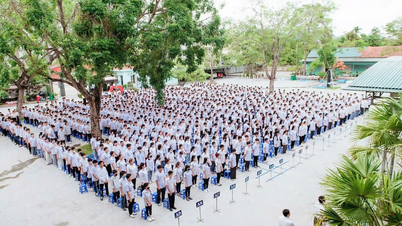Education experts, Master Nguyen Thanh Dung and Doctor Tran Nam Dung, believe that the percentile in 2025 enrollment is a remarkable effort to standardize the scale, bringing fairness and transparency between methods. However, this method is not perfect, leading to many paradoxes.
The year 2025 marks an important turning point in the university admission system in Vietnam with the widespread application of the percentile equating method to standardize scores between admission methods.
According to the regulations of the Ministry of Education and Training , percentiles are used to determine the relative position of candidates in the score distribution, in order to bring admission forms such as high school graduation exam scores, capacity assessment exams, school records, or international certificates to a common scale. The main goal is to increase fairness, transparency and reduce inequality between different subject combinations or methods.
For example, the Ministry of Education and Training has announced the percentile for 7 popular combinations such as A00 (Math, Physics, Chemistry), A01 (Math, Physics, English), B00 (Math, Chemistry, Biology), helping universities build a standard score conversion table. However, after the admission results were announced at the end of August 2025, this method received many mixed opinions, with some cases showing the unreasonableness in the conversion, leading to the situation where candidates failed in one method but were admitted in another.
This analysis will explore the aspects of percentiles in depth, based on real-world data and specific examples, to assess whether they truly deliver equity or are just a temporary solution with many limitations.
Meaning and benefits of percentiles
Percentile is a statistical tool that measures the position of a score relative to the entire data set. In university admissions 2025, it is applied to convert scores between admission methods, ensuring that candidates, regardless of which exam they take, are evaluated on the same scale.
For example, if a candidate scores 90th percentile on the Ho Chi Minh City National University's aptitude test, that score will be mapped to the equivalent score in the top 10% of the corresponding high school exam, such as B00. The first benefit is to increase fairness between subject combinations.

Candidates taking the 2025 high school graduation exam in Ho Chi Minh City. (Photo: Nguyen Hue)
In 2025, the high school score distribution shows a large difference: Math has more than 50% of candidates below average, while Chemistry has higher scores. Percentiles help schools adjust, for example, 28.75 A00 points are equivalent to 27.5 D01 points, avoiding the situation where candidates in combinations that are easy to get high scores will have an advantage.
Second, this method promotes transparency and flexibility. Schools such as Hanoi University of Science and Technology have used percentiles to convert between TSA (separate test), competency assessment and high school scores, and published detailed conversion tables for candidates to predict their chances of admission. This helps candidates easily compare their abilities with the requirements of their major, especially in the context of more than 110 schools using the competency assessment results of Ho Chi Minh City National University.
Furthermore, percentiles more accurately reflect the relative ability of candidates, based not only on absolute scores but also on position within the entire test group.
In 2025, with more than 1.16 million candidates taking the high school entrance exam and about 152,729 candidates taking the competency assessment exam, this method has contributed to a record increase in benchmark scores in some majors, such as 24 majors achieving 29-30 points according to the high school entrance exam method, reflecting high competition and clear differentiation. Overall, the percentile is a step forward in modernizing admissions, helping to reduce inequality between diverse methods, from separate exams to international certificates.
Challenges and incongruities in applying percentiles
Despite its benefits, the application of the 2025 percentile has revealed many challenges, leading to unreasonable cases. First is the difference in database and score distribution between exams. The national high school exam with more than 1 million candidates focuses on specialized knowledge (for example, group B00 with a 30-point scale, emphasizing Math, Chemistry, Biology).
In contrast, the assessment of Ho Chi Minh City National University's capacity only had 152,729 candidates, mainly good students from the South, with a test structure of 120 questions (only 3 Chemistry questions and 3 Biology questions), emphasizing synthetic thinking and a scale of 1,200 points.
Uneven score distribution: High school is close to normal distribution with low average score (Math ~5.5/10), while the GPA is concentrated at 600-800/1,200. The conversion of percentiles based on relative position (top 10% GPA = top 10% high school) ignores this difference, leading to distortion. For example, a candidate who scores 900/1,200 in the competency assessment (top 10%) can be converted to 24-25/30 B00 high school, even though he/she is weak in specialized knowledge of Chemistry - Biology.

Candidates look at the exam room diagram for the 2025 high school graduation exam in Hanoi. (Photo: Thach Thao)
Second, the percentiles are not appropriate for the specific field of study. Fields such as Medicine (B00) require in-depth specialized knowledge, but the GRE only has 6/120 related questions, making the conversion not reflect the true ability. This leads to a paradox: Candidates fail the high school exam (due to low Biology scores) but pass the GRE thanks to strong linguistic or logical thinking.
Furthermore, the set of candidates for the "selective" ability assessment, making the top 10% of the GPA can be equivalent to a higher high school score than the actual score, causing disadvantages for high school candidates. Some schools such as Saigon University encountered difficulties when the initial percentile framework lacked the A00, C00 combination, which had to be added later, showing that the implementation was complicated and easily misunderstood.
Finally, the conversion may create social injustice: Northern candidates (with less access to the National Eligibility Test) are disadvantaged compared to the South, and the "strange" benchmark in 2025 (such as 29.92 A00 in some majors) reflects this trend, with the risk of reducing the quality of input to specialized majors.
Real-life examples and analysis
The year 2025 witnessed many examples illustrating the unreasonableness of percentiles. According to statistics, 6 majors have a standard score of 30 absolute points according to high school, but through conversion, some candidates with a capacity assessment score of 950/1,200 (equivalent to 25/30 B00) were admitted to the medical major, even though their high school score was only 18-20/30.
A specific case: Two candidates reported failing the medical major based on their high school exam scores (B00 ~18/30, top 50%) but were more than capable of passing the competency assessment (950+/1,200, top 10%), because the competency assessment did not require in-depth knowledge of Biology. This shows that the conversion ignored the exam content, leading to candidates lacking expertise still being admitted, affecting the quality of training.
Similarly, for the valedictorian of the 2025 national excellent student exam, the percentile is not applied to convert between subjects, but if tested, the valedictorian of Chemistry - Biology has an advantage in entering Medicine over the valedictorian of Literature or English, due to the specific nature of the industry. The lack of a conversion framework between subjects (with different numbers of candidates: Math ~500, Japanese less) makes this method unfeasible for direct admission.
In addition, the "strange" benchmark scores at Police schools (the highest is 26.28 combined with the Ministry of Public Security's capacity assessment) show that the percentile can increase the benchmark scores abnormally, reflecting the tendency to prioritize specific examination methods. These examples confirm: The percentile is wrong from the beginning when assuming similar exams, leading to actual injustice.
Suggested improvements
To overcome this, the Ministry of Education and Training needs to separate the criteria for each method, avoiding direct conversion. For specialized fields such as Medicine, schools should apply the coefficient for the main subject (Chemistry - Biology) in the conversion, or require additional tests.
Improve the competency assessment structure by increasing the Chemistry-Biology questions (currently only 6/120) to better match B00. In addition, publicly release the conversion table validation study and detailed instructions to reduce misunderstandings. Finally, encourage schools to use statistical data to make adjustments, ensuring that percentiles are truly fair.
The 2025 admissions percentile is a remarkable effort to standardize the scale, bringing fairness and transparency between methods. However, with the irrationalities from data differences, score distribution and industry characteristics, this method is not perfect, leading to practical paradoxes such as candidates failing based on high school exam scores but are more than capable of passing based on the results of the capacity assessment. To be more effective, it is necessary to improve implementation and closely inspect.
Finally, enrollment is not just about numbers, but must ensure input quality that meets social needs.
Source: https://vtcnews.vn/bach-phan-vi-trong-tuyen-sinh-dai-hoc-chua-hoan-hao-dan-toi-khong-it-nghich-ly-ar962357.html



![[Photo] General Secretary To Lam attends the opening ceremony of the National Achievements Exhibition](https://vphoto.vietnam.vn/thumb/1200x675/vietnam/resource/IMAGE/2025/8/28/d371751d37634474bb3d91c6f701be7f)
![[Photo] General Secretary To Lam presents the 45-year Party membership badge to comrade Phan Dinh Trac](https://vphoto.vietnam.vn/thumb/1200x675/vietnam/resource/IMAGE/2025/8/28/e2f08c400e504e38ac694bc6142ac331)
![[Photo] National Assembly Chairman Tran Thanh Man holds talks with New Zealand Parliament Chairman](https://vphoto.vietnam.vn/thumb/1200x675/vietnam/resource/IMAGE/2025/8/28/c90fcbe09a1d4a028b7623ae366b741d)

![[Photo] Politburo works with the Standing Committee of Cao Bang Provincial Party Committee and Hue City Party Committee](https://vphoto.vietnam.vn/thumb/1200x675/vietnam/resource/IMAGE/2025/8/28/fee8a847b1ff45188749eb0299c512b2)
![[Photo] Red flag with yellow star flutters in France on National Day September 2](https://vphoto.vietnam.vn/thumb/1200x675/vietnam/resource/IMAGE/2025/8/28/f6fc12215220488bb859230b86b9cc12)























































































Comment (0)